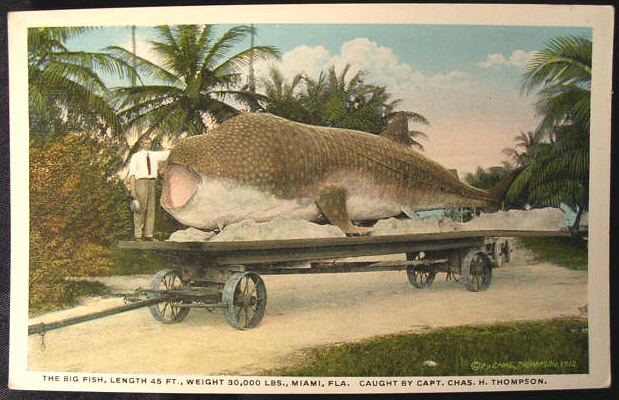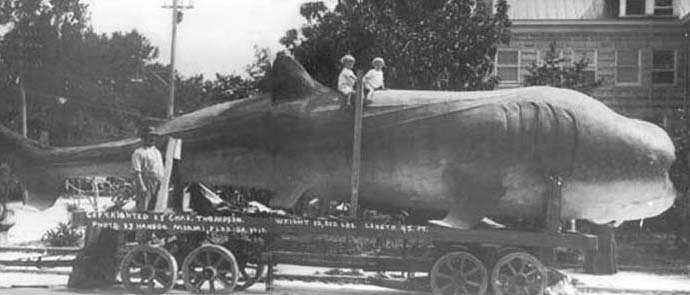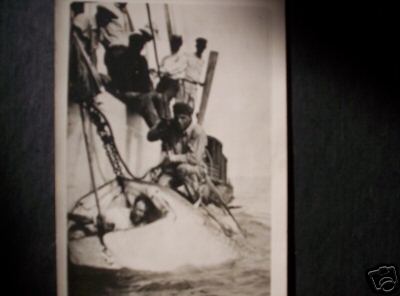Thompson’s Sea Serpent Hunt
Posted by: Loren Coleman on January 29th, 2008

One thing leads to another. Looking into the new mystery photo postcard has taken me to more of the backstory that involves a Sea Serpent hunt exactly 100 years ago.
In 1908, a Little River couple on an outing on Biscayne Bay reported seeing a sea serpent with a 30-foot-long body and a long, slender neck.
An intrepid and well-known fisherman, Capt. Charles Thompson, set off after the sea monster. Thompson was certainly the man for the job: He had fished with four U.S. presidents and powerful industrialists such as John Jacob Astor and William Vanderbilt. Even the Miami Metropolis latched onto the hunt. “The people may rest assured,” the Metropolis wrote on July 24, 1908. “If there is anything that swims of extraordinary dimensions, playing peek-a-boo with Captain Charley Thompson up around Little River within the next few days, its name will be ‘mud.'” Thompson never snagged the serpent, but four years later he did hook a 30,000-pound whale shark that he toured around the country until the stench got so bad he was forced to destroy what was left of the carcass.Source
In The Wake of the Sea-Serpents by Bernard Heuvelmans, neither in its text nor via its detailed listing of sightings, mentions this Biscayne Bay sighting of 1908.
Such an absence is not to convey that the 1908 account is new to researchers, but it may be. I look forward to Gary Mangiacopra’s forthcoming comprehensive review of Atlantic Sea Serpent sightings by Coachwhip Publications for more details, perhaps, on this encounter.
For the record, Thompson’s caught fish was quite well-known during its time:
The largest Keys fish story took place in 1912 just off of Knight’s Key. Captain Charles Thompson of Miami harpooned a 38-foot-long whale shark that reportedly took about 39 hours, five harpoons and more than 100 bullets to subdue. The 26,594-pound whale shark was towed to Miami, preserved, stuffed and exhibited on a railroad flat car. The sign on the flat car read “weight 30,000 lbs. Length 45 ft.” All went well until it was accidentally destroyed by fire in 1922.Source

Also worthy of noting is that when this whale shark was taken, it was recorded as the second discovery of this fish in these waters. The famed American ichthyologist and cetologist Dr. Eugene Willis Gudger wrote a paper on Thompson’s whale shark.

Science 22 August 1913:
Vol. 38. no. 973, p. 270
DOI: 10.1126/science.38.973.270
E. W. Gudger
“A Second Capture of the Whale Shark, Rhinedon typus, in Florida Waters.”
which was cited in
Science 48, 622
“Modern Navigation.”
Chas. L. Poor (1918)
and
Science 27 August 1920:
Vol. 52. no. 1339, pp. 191 – 192
DOI: 10.1126/science.52.1339.191
E. W. Gudger
“A Third Capture on the Florida Coast of the Whale Shark, Rhinedon typus.”
+++++++++
TornadoBob found a postcard on eBay that appears to show the same whale shark. Below is that postcard. Here is what it says about it (excuse the all caps in the description): “RPPC POSTCARD SAYS WEIGHT 30,000 LBS LENGTH 45 FT. COPYRIGHTED BY (CAPT) CHAS. THOMPSON 1913 PHOTO BY HANDGO MIAMI FLORIDA (SHOWS MAN SITTING IN MOUTH OF FISH THE IMAGE IS SHARP AND CLEAR MY CHEAP DIGITAL IMAGE IS NOT) POSTMARKED 1914 ”

About Loren Coleman
Loren Coleman is one of the world’s leading cryptozoologists, some say “the” leading living cryptozoologist. Certainly, he is acknowledged as the current living American researcher and writer who has most popularized cryptozoology in the late 20th and early 21st centuries.
Starting his fieldwork and investigations in 1960, after traveling and trekking extensively in pursuit of cryptozoological mysteries, Coleman began writing to share his experiences in 1969. An honorary member of Ivan T. Sanderson’s Society for the Investigation of the Unexplained in the 1970s, Coleman has been bestowed with similar honorary memberships of the North Idaho College Cryptozoology Club in 1983, and in subsequent years, that of the British Columbia Scientific Cryptozoology Club, CryptoSafari International, and other international organizations. He was also a Life Member and Benefactor of the International Society of Cryptozoology (now-defunct).
Loren Coleman’s daily blog, as a member of the Cryptomundo Team, served as an ongoing avenue of communication for the ever-growing body of cryptozoo news from 2005 through 2013. He returned as an infrequent contributor beginning Halloween week of 2015.
Coleman is the founder in 2003, and current director of the International Cryptozoology Museum in Portland, Maine.










What I find amusing is the idea that Captain Thompson was qualified to look for sea serpents because he had been fishing with four presidents and a Vanderbilt. Of course he did catch the whale shark later, but this just tells me that Captain Thompson was a good fisherman with a lot of money so that he could buy the equipment to look for serpents and fish for whale sharks. If I had a few million to spre , I would definitely be doing some high tech searching for some lake monsters in clear water like Loch Morar or Lochy. Someone want to give me a loan? : )
This does explain why a fisherman was pottering around with harpoons and firearms in his boat.
Good find Loren, clears those questions up nicely.
Interesting memorabilia.
There is a little bit of mystery about how the shark was destroyed though. The first articles says it was destroyed by Thompson due to its stench while the second claims it was fire that destroyed it accidentally.
Also, Thompson’s shark was bigger than the one from Pakistan. Why did it weigh only 30,000 lbs compared to 47,300? More mystery.
The one he stuffed was 7 feet longer than the one he harpooned, too.
I do believe it, that it was destroyed because of its stench.
At least something here stinks. Must be a fish story. 😉
you should have seen the one that got away? Ann unknown? lol